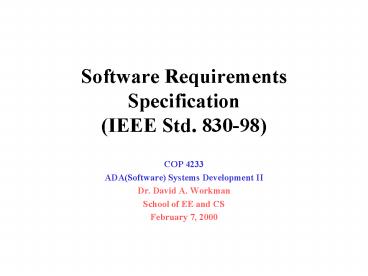Software Requirements Specification IEEE Std' 83098 - PowerPoint PPT Presentation
1 / 4
Title:
Software Requirements Specification IEEE Std' 83098
Description:
Glossary should be included here. Define the most. important terms in this section. ... appendix for a complete Glossary. Reference all documents. used to ... – PowerPoint PPT presentation
Number of Views:356
Avg rating:3.0/5.0
Title: Software Requirements Specification IEEE Std' 83098
1
Software RequirementsSpecification(IEEE Std.
830-98)
- COP 4233
- ADA(Software) Systems Development II
- Dr. David A. Workman
- School of EE and CS
- February 7, 2000
2
Software Requirements Specification1
Briefly An abstract of 2.1
1 IEEE Std 830-1998
- Title
- TOC
- 1. Introduction
- 1.1 Purpose
- 1.2 Scope
- 1.3 Definitions. Acronyms, and Abbreviations
- 1.4 References
- 1.5 Overview
Identify the product being produced (e.g. PAS or
PCS ). Give a general statement of what this
system will be capable doing, and what it will
not do. Describe briefly the application (problem
) for which this product will be used.
Material from the Use Case (Requirements) Model
on Glossary should be included here. Define the
most important terms in this section. Describe
the UML diagram types that will be used in this
document andwhat kind of information they
convey. Point to an appendix for a complete
Glossary.
Reference all documents used to write the SRS.
E.g.Use Case Model and Problem Statement
Overview of the SRS. Focus onthe organization
of Section 3. Give rationale as it relates to
the Unified Process.
3
Software Requirements Specification1
1 IEEE Std 830-1998
- 2. Overall Description
- 2.1 Product Perspective
- 2.1.2 (Summarizes Actor types and how they use
the system) - 2.1.4 ( Summarizes interfaces required with
other programs upon which this project
depends) - 2.2 Product Functions
- 2.3 User Characteristics
- 2.4 Constraints
- ( c) and (g) only
- 2.5 Assumptions and Dependencies
- Preconditions and assumptions needed before your
product can operatecorrectly.
Material from the Use Case (Requirements) Model
on System Concept should be included here.
Define theproblem and motivate the need for the
system being developed in more depth. Include
the Business Model (Collaboration diagram) and
discuss how proposed system will address client
needs.
System Usc Case Diagram plus narative. Revise
from Requirements Model.
Revised from User Interface section of
theRequirements Model.
4
Software Requirements Specification1
1 IEEE Std 830-1998
- 3.0 Specific Requirements
- 3.1 System Use Cases
- Begin this section with "Big" picture of
system. Give System Collaboration Diagram plus
the narative "glue". Rest of section organized
by use-case. - Present system use-case realizations in detail.
Each subsection will describe a system use-case
realization. This section should look very much
like the main body of the Use Case Model. Each
use-case realization should employ a
collaboration diagram plus any other diagrams
that are appropriate. The collaboration diagrams
should identify relevant analysis classes and
packages. - 3.2 System Classes and Packages
- Static system architecture presented in the form
of a System Class Diagram. This shows the
relationships among all analysis classes and
packages in the system. This introduction should
give the big picture - subsections describe
analysis packages and classes in detail. 3.2.1
Analysis Packages (detail) - 3.2.2 Analysis Classes (detail)
- Index
- Appendices































